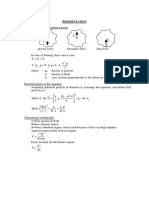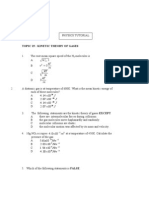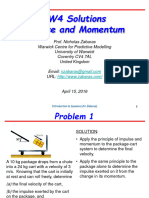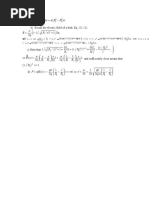Problem39 52
Uploaded by
IENCSProblem39 52
Uploaded by
IENCSh h h h
λ .
39.52: a) p 2mE 3 3mkT
2m( kT )
2
b) We would roughly expect the length scale of the problem to go like V 1 3 (e.g., for a
cube
V l so l v
3 1 3 and for a sphere V 4 πR , so R ( 3 V
3
3
4π
13
V 1 3 ). Let n
be the number of molecules along one length (again, think of a cube) so that n 3 N , the total
number of particles in the volume. So n N 1 3 . Thus, the typical spacing between particles is
13
l V
. The exact relationship will change depending on the geometry, but the scaling is
n N
correct up to a multiplicative constant.
13 13
V h V Nh 3
c) λ V .
N 3mkT N 3mkT 3 2
6.02 10 particles mol 1.00 mol 6.63 10 J s
23 34 3
3.03 10 8 m 3
d) Vwave
3 2.66 10 kg 1.38 10 J K 293 K
26 23 32
30.3 mm3 .
NkT
PV NkT VSTP
P
6.02 10 23
particles mol 1.00 mol 1.38 10 23 J K 293 K
1.01 105 Pa
VSTP 0.0241 m 2.41 10 7 mm 3 .
3
VSTP is far larger than V wave so the wave nature is not important.
1.00 kg
e) N 5.59 10 24 Ag atoms( conduction e).
1.79 10 25 kg atom
(5.59 1024 electrons)(6.63 1034 J s)3
Vwave 31 23
1.40 m 3 .
[(3)(9.11 10 kg)(1.38 10 J K)(293 K)]3 2
1.00 kg 5
VReal 1.05 10 4 kg m 3 9.52 10 m .
3
The real volume is much smaller than the wave limit volume. So, the wave nature of the
electrons must be accounted for.
You might also like
- MODULE#7 - Incompressible Flow in Pipe - Feb100% (1)MODULE#7 - Incompressible Flow in Pipe - Feb46 pages
- 3 Electrons and Holes in Semiconductors: Chap. 3No ratings yet3 Electrons and Holes in Semiconductors: Chap. 328 pages
- 5.20 CE Quantum Concentration For Ideal GasNo ratings yet5.20 CE Quantum Concentration For Ideal Gas10 pages
- Answers & Solution - Major Test - 3 (ADV) DT. 27-03-2022No ratings yetAnswers & Solution - Major Test - 3 (ADV) DT. 27-03-202229 pages
- JEE Advanced Final Practice Test-2 - Paper-1 - SolutionsNo ratings yetJEE Advanced Final Practice Test-2 - Paper-1 - Solutions17 pages
- Lect - 10 - MDOF - Equations - of - Motion - Part 4No ratings yetLect - 10 - MDOF - Equations - of - Motion - Part 44 pages
- 18-09-2024 Arjuna JEE-2025 PCM SolutionsNo ratings yet18-09-2024 Arjuna JEE-2025 PCM Solutions8 pages
- (Pearson Series in Economics) Robert Pindyck, Daniel Rubinfeld-Microeconomics-Prentice Hall (2012)No ratings yet(Pearson Series in Economics) Robert Pindyck, Daniel Rubinfeld-Microeconomics-Prentice Hall (2012)2 pages
- Matter and Interaction Chapter 04 SolutionsNo ratings yetMatter and Interaction Chapter 04 Solutions71 pages
- 26.01.23 - SR MPC (Cio& Cao) - Jee Main Model - gtm-22 - QP - An - FinalNo ratings yet26.01.23 - SR MPC (Cio& Cao) - Jee Main Model - gtm-22 - QP - An - Final18 pages
- 30 01 2023 Physics - Paper+With+Ans - MorningNo ratings yet30 01 2023 Physics - Paper+With+Ans - Morning9 pages
- P338SolutionsToProblemsSimilarToThoseAskedInAssignments_022228No ratings yetP338SolutionsToProblemsSimilarToThoseAskedInAssignments_0222289 pages
- Chapter - 6 The Barrier Potential (Continued From Chapter 4)No ratings yetChapter - 6 The Barrier Potential (Continued From Chapter 4)9 pages
- CH3 - Properties of Gases and Vapours-2No ratings yetCH3 - Properties of Gases and Vapours-218 pages
- μ μ k r r q kq U: J 357 - 0 m 150 - 0 1 m 354 - 0 1) C 30 - 4) (C 40 - 2 (1 1No ratings yetμ μ k r r q kq U: J 357 - 0 m 150 - 0 1 m 354 - 0 1) C 30 - 4) (C 40 - 2 (1 12 pages
- ME:5160 (58:160) Intermediate Mechanics of Fluids Fall 2021 - HW4 SolutionNo ratings yetME:5160 (58:160) Intermediate Mechanics of Fluids Fall 2021 - HW4 Solution5 pages
- Electron Beam-Specimen Interactions and Simulation Methods in MicroscopyFrom EverandElectron Beam-Specimen Interactions and Simulation Methods in MicroscopyNo ratings yet
- Investigation of Tensile Properties of PLA-brass Composite Using FDMNo ratings yetInvestigation of Tensile Properties of PLA-brass Composite Using FDM13 pages
- Aluminum 7005-T6, 7005-T63, and 7005-T6351No ratings yetAluminum 7005-T6, 7005-T63, and 7005-T63513 pages
- Nondestructive Testing or Non-Destructive Testing (NDT) Is A Wide Group of Analysis Techniques UsedNo ratings yetNondestructive Testing or Non-Destructive Testing (NDT) Is A Wide Group of Analysis Techniques Used1 page
- Temperature and Heat: Heat Is A Flow of Energy Due To Temperature DifferencesNo ratings yetTemperature and Heat: Heat Is A Flow of Energy Due To Temperature Differences16 pages
- Experimental Investigation of Deposition and Wall Growth in Water Saturated Hydrocarbon Pipelines in The Absence of Free WaterNo ratings yetExperimental Investigation of Deposition and Wall Growth in Water Saturated Hydrocarbon Pipelines in The Absence of Free Water7 pages
- Exchange Mechanisms in Europium ChalcogenidesNo ratings yetExchange Mechanisms in Europium Chalcogenides10 pages
- Practice Set 2 (KCL, KVL, Series and Parallel Circuits)No ratings yetPractice Set 2 (KCL, KVL, Series and Parallel Circuits)13 pages
- Chapter 4-Theory-of-Elasticity-PG-Course PDFNo ratings yetChapter 4-Theory-of-Elasticity-PG-Course PDF15 pages
- Thick Wall Cylinder: Module Name: ME2061 Semester: 3No ratings yetThick Wall Cylinder: Module Name: ME2061 Semester: 327 pages























































































































